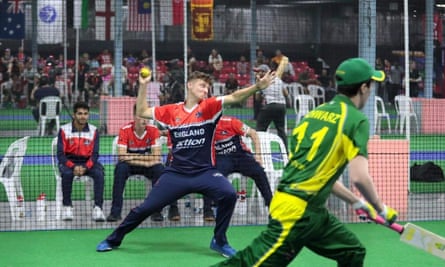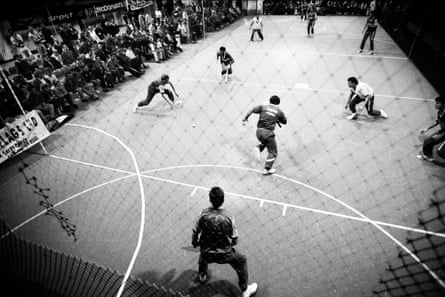
IIf you love cricket but hate the idea of winter nets – the waiting in queues, the cold, the squeaking silence – then you might enjoy a high-energy indoor cricket game. But trying to familiarize yourself with the game’s various formats and its existence in the UK is like navigating your way through a particularly confusing bag of soggy knitwear.
Historically there are two forms of indoor cricket. The first is played in a general sports hall, with the idea of roughly replicating outdoor cricket – but indoors. Mats are sometimes set, but there are no specific laws and no specific formats, and the game often emerges on an ad hoc basis. The second is “official” indoor cricket, played on a pitch with tension nets and a pitch 30 meters long, 10-12 meters wide and 4-5 meters high – a format played primarily in Australia, but is also widespread in New Zealand and South Africa, with international competitions and a world championship.
The England and Wales Cricket Board runs two competitions: a girls’ indoor competition for under-13s and under-15s and an indoor National Club Championship. Both fall into the category of general gymnasiums.
The ECB took over the running of the girls’ competition from the Lady Taverners. It is open to all schools and is played from January to Easter. The district winners compete at five regional venues across the country, then the five regional winners play in the national final at Lord’s in the week before the May half-term.
The number of participating schools has increased generously: 1,903 have signed on the dotted line for 2024, an increase of 400 since 2015.
“It’s really encouraging,” says Sue Laister, ECB’s competition manager for women’s and girls’ football. “Not only is the game easy to play, but due to the fact that there are eight overs per team, it can be played within 45 minutes to an hour, which is the usual length of a school lesson or lunch break.”
“Compared to outdoor cricket, it is easier for schools to organize as schools usually have access to a gymnasium or sports hall and you need less specialist equipment.” Teams use a plastic bat and there is one innings, no LBWs, maximum of two Overs per bowler, and players must retire once they reach 15 – although if the rest of the team is out, they can bat again.
“It’s a really good introduction to the game,” says Laister. “Everyone takes part, it’s a fun, engaging and fast-paced format.”
Approximately 500 teams across the country then play in the Indoor National Club Championship run by the ECB. The winners of each county competition play in a regional final, with a national final in March, again at Lord’s. This is a six-a-side competition with 12 overs per team (maximum three overs per bowler) and matches are completed in approximately one hour.
That being said, the Bucs (British Universities and Colleges Sport) indoor cricket leagues are very popular, partly due to the nature of university semesters which leave little time for outdoor university cricket in the summer. In fact, the University of Kent won the ECB Indoor National Club Championship in 2023, beating the University of Sheffield in the final.
Jen Barden is cricket development manager at Lancashire Foundation. She remembers indoor cricket lasting through the winter 20 years ago and recognizes that there is now a small gap in the offering, but there is a reason for it: “It is an expensive activity. In one hour only 16 children took part and you have to hire a venue and have a referee too.” Lancashire generally doesn’t run competitions but is happy to provide advice and equipment to anyone who wants it. “It depends a little bit on who has the fault in a particular area.” Barden recalls a purpose-built Tension Net indoor cricket center in Rochdale, “but now the closest one is in Birmingham.”

That brings us to Action Indoor Cricket England and its chairman Duncan Norris. Norris is the English delegate to the World Indoor Cricket Federation and Action Indoor Cricket, based in Birmingham, is responsible for national, domestic and international teams and tournaments.
after newsletter advertising
“In the 80s and 90s there were over 60 cricket centers with tension nets and the participation was huge,” he says. “People like Mike Gatting and Asif Din all started playing the format as an additional form. Unfortunately, it is very difficult to make the commercial model work in this country as tariffs are high and activity is very seasonal. Gradually most of these centers have been closed.” There are now just four voltage network centers in the country – all based in the Midlands – in Derby, Nottingham, Leicester and Birmingham.
Norris’ involvement came about when he bought the Bristol indoor cricket center (which later closed following Covid financial pressures) from administration in 2009 and reinvested in it. He was then brought in by the ECB as a consultant before “in 2014 the ECB appointed my company to manage, manage and develop the game and we signed a letter of intent.”
He is a big supporter of the tension-net version of indoor cricket – both as a way to develop cricketers and as a participation sport.

“It is a very demanding competition and everyone has to bat, bowl and catch, there is no hiding place. Over the last 30 years, cricket has changed dramatically, becoming shorter and more dynamic – and indoor skills are increasingly being seen on outdoor pitches. In the indoor format, the fielding skills are electrifying.”
Between September and March, Action Indoor Cricket at the Birmingham Center in Stockland Green hosts 24 weeks of Monday to Friday evening leagues and 24 weekends of national competitions for all ages from under 11s through to Masters (50 plus). He is very proud of the large number of people who come to play. “That’s around 1,000 games in the winter months, with 16 players involved per game – in the summer a club would do well to play 40 to 50 games.” The players also come from different backgrounds, with 60% of those playing in the local Play midweek leagues, have an Asian background.
Perhaps most notably, Norris believes the game will soon move into a new sphere – something that could attract the attention of the ECB and even the International Cricket Council. “Globally, the game is about to explode with the United Arab Emirates joining the fray with three major centers in Dubai.”
